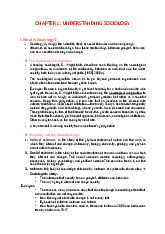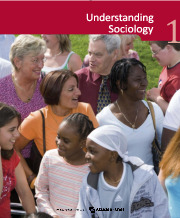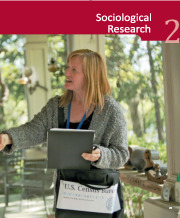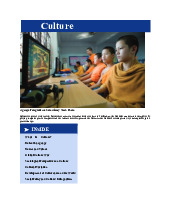









Preview text:
International University HCMC School of Business Administration
International University – VNU-HCMC
School of Business Administration
INTRODUCTTION TO SOCIOLOGY
REPORT: Group task_Week 5_Group 12
Instructor: P.T.Nhat Date: 25/07/2024 Members: Name Student ID Contribution Lê Ngọc Trà My FAACIU22040 100% Huỳnh Tuyết Nhi FAACIU22048 100% Nguyễn Trâm Anh FAFBIU22025 100% Trần Kim Hoàng BABAWE21759 100% Ngô Trường Thịnh EEACIU17014 100% Nguyễn Thị Diệu Hương BABAFNIU22098 0%
Question 1. Students are asked to choose an ethnic group in Vietnam or other
countries, and analyze their culture. For example, Dao (in the north), Chinese, Khmer, Tày, Mông, Mường
- Where have they been living?
- What are common heritages and cultures? (e.g., customs, knowledge, ideas, values
- How have they learned and transmitted such common heritages and cultures from the past to the present?
- How have they preserved their distinctive culture? (through videos, arts, etc.) ANSWER
Where have they been living?
Other names: Khmer Krom, Khmer Loe
Language: The Khmer people speak Khmer - a language belonging to the
MonKhmer group in the Austroasiatic language family.
Residence: Based on ecological characteristics and natural environment, the
distribution of Khmer people in the Mekong Delta can be divided into the following three main regions: •
Inland region: this is the first area to have been inhabited by the Khmer in the Mekong Delta. •
Coastal area: extending from Tra Vinh through Soc Trang to Bac Lieu. •
Southwest border mountains: belonging to An Giang Province and Kien Giang
Province, where That Son mountain range, Sap Mountain, and Vong The Mountain can be found.
History: Many studies have confirmed that the Khmer people in Vietnam are
descendants of immigrants from the Chenla Kingdom, a Khmer civilization
considered to be the predecessor of the Khmer empire at Angkor. They migrated to
this area in waves for a variety of reasons. Along with the Vietnamese and the
Chinese, the Khmer were among the earliest populations in the Mekong Delta.
Custom: The costume for Khmer women is the sampet chon kpal, a special dress
made from a wide fabric wrapped around the body and passed between the legs to make short, puffy pants.
Khmer women wear skirts decorated with motifs of oval inlays, flowers and stripes.
The dresses are worn with shorts and a close shirt, with open neck and short sleeves.
The daily costume of women is similar to the Vietnamese ethnic majority Kinh’s
ao ba ba (a blouse worn by southerners) and khan ran (striped scarf) on the head or shoulders.
The traditional costume of Khmer men is a sarong, a long piece of delicately
embroidered cloth. They also often wear sarongs and black blouses.
Today, Khmer only wear traditional costumes on special occasions, such as art
performances, ceremonial rites, wedding ceremonies, and festivals.
Unusual hats and masks are an indispensable part of traditional costumes. The hats
are designed in the shape of heads and sacred animals.
- Housing: Khmer people used to live in houses or stilt houses. However, hardly
any people still live in stilt houses anymore. For the past few decades, the
Khmer people have all been living in houses.
What are common heritages and cultures?
Tradition holiday: Chol Chnam Thmay (a festival expressing the wish for a new
year of favourable rain and wind, and bountiful crops).The Chol Chnam Thmay
Festival of the Khmer ethnic minority people usually takes place around mid-April
every year.The Chol Chnam Thmay Festival features the culture of the Mekong
Delta and typical rice-growing residents in Southeast Asia, including the Khmer
people whose festivals are closely associated with the life cycle of rice.
Residents think that the time that they choose to hold the festival is the transition
period between rainy and sunny seasons when plants and trees grow well. So, it is
considered as the beginning of a favourable year.
The festival does not only help unite the community but also is an occasion for
people to communicate with nature through the rain-praying ritual. Additionally,
the festival is an occasion for the Khmer people to pay tribute to their ancestors.
Ok-ang Bok Festival (moon worshipping ceremony) are the two major
festivals of the year.Ok Om Bok is an important cultural festival for the Khmer
people held on the full moon day of the 10th lunar month every year.Ok Om Bok
features folk religion originated from Buddhism. The festival opens by a Ngo Boat
Race (Um Tuk Ngua in the Khmer language), one of the most attractive activities
of the Khmers. The race drew hundreds of thousands of Khmer people in the region and tourists nationwide.
Cuisine: The main food of the Khmer people in the Mekong Delta is sticky rice.
'Tuksamlo' (noodle soup with sauce made from various fish) is a favourite dish
of the Khmer people, and is indispensable on the first day of the Tet holiday at the temple.
https://www.youtube.com/watch?v=oOFaIYhQPtk
https://www.youtube.com/watch?v=93SEG3WUnNg
- Religious beliefs : Like some other ethnic groups, the Khmer people consider
Buddhism to be the core of their social and spiritual life. This issue has been
mentioned in many research works. Here, we only mention a few quite unique
Buddhist festival activities. At the beginning of the year, New Year's greetings
are held quite lavishly. On this day, people in the phum - squirrels are very happy
because they have created blessings and been blessed. Children can have fun
freely. This is quite similar to Vietnamese activities. But what is worth noting is
that on the second day, in the morning, Buddhists offer offerings to Buddha and
offer rice to the monks. They went to the temple to continue listening to sermons
about Buddha and to pray for peace. On the afternoon of the second day of the
Lunar New Year, they held a sand mountain building ceremony together.
Everyone found clean sand to bring home and pile it up around the Buddha
temple, outside the corridor around the main hall. These sand mountains
symbolize the universe. Then they performed the refuge ceremony on the
mountain and the next morning, the ceremony to leave the world. The custom of
building sand mountains originates from a long-standing legend of the Southern
Khmer people about a person who specialized in hunting animals. Throughout
his life he killed many animals, so at the end of his life he built sand mountains
to practice and accumulate virtue... In addition, the Khmer people also have folk
beliefs and festivals that contain many Hindu elements but are integrated into Buddhism.
Family and community: Emphasis on family and community relationships. Respect
for elders and filial piety are highly valued. On the afternoon of the last day of the
old year and the last day of the Chol - Chnam - Thmay festival, Khmer people
organize rice offerings to grandparents and parents at home. The Khmer language
calls offering rice Sen - Pren. The rice tray is often presented in the most solemn
place in the family. In addition to offerings such as a glass of wine, a glass of tea, a
plate of betel and areca, incense, fruit, etc., the tray must have seven bowls of rice
and seven pairs of chopsticks to serve the 7 generations of the family. of the
worshiper himself. The sequence of 7 generations from small to large is as follows:
- First generation: Great-grandchildren and great-grandchildren's peers.
- Second generation: you and your peers.
- Third generation: you and your peers.
- Fourth generation: is the same clan as the worshiper, such as siblings, uncles, aunts, uncles, etc.
- Fifth generation: parents and people equal to parents such as uncles, aunts, aunts, etc.
- Sixth generation: grandfather, grandmother, maternal grandfather, maternal
grandmother and people equal to the great-grandparents.
- The seventh generation: Mr. Coc, Mrs. Coc (including grandparents) and their peers.
Rice farming: Central to their lifestyle. Traditional festivals and customs often
revolve around the rice harvest cycle. - Growing high-quality rice linked to
production and consumption of agricultural products is being determined to be
implemented by many localities in Tra Vinh province. The goal is to help farmers,
especially in the Khmer ethnic region, produce increasingly quality agricultural
products and increase income from rice.
Angkor Wat: A source of great pride and a symbol of the architectural and artistic
achievements of Khmer civilization. Angkor Wat is a combination of two basic
features of Khmer architecture: temple-mountain architecture along with long and
narrow corridors. This architecture symbolizes Mount Meru, home of the gods in
Hindu legend: between a moat and a 3.6 km (2.2 mile) long wall is the three-story
main hall with rectangular architecture. , connected by deep corridors. The center
of the temple is a complex of 5 towers with a central tower and four towers at the
four square corners. Unlike other Angkor-style temples, Angkor Wat faces west and
there is still no agreed-upon interpretation of what this means. The temple is
admired for the grandeur and harmony of its architecture, the richness of its
sculpture and the large number of deities adorning its stone walls. Cultural transmission:
Word of mouth: During Tet days, at night in the Khmer pagoda yard, the stage is
brightly lit, people gather to listen to sermons and stories. They have a rich treasure
of ancient stories such as myths, legends, fairy tales, fables, jokes and a traditional
theater scene. The Khmer cultural program is truly rich. Their folk legends told in
this festival are performed with the accompaniment of a musical instrument called
"Cham Rieng", brought to the stage called "Du Ke". Their lyrics have content taken
from folk fairy tales, legends about history, morality, about good always
overcoming evil... Especially the type of fairy tales that are more about teachings
are considered An activity that plays an important role in the process of forming the personality of youth.
Religious rituals: For Khmer people, pagodas are considered the heart of the
community in Phum - Soc. The pagoda is both a place of religious worship and a
cultural institution for local residents. Pagodas play an extremely important role in
the cultural and spiritual life of the Khmer people. The pagoda is the bright spot of
Phum Soc: a place for cultural and religious activities of the Khmer people; This is
where they learn scriptures, letters, and morals to be human. Even more sacred, the
cremation and preservation of the remains of relatives and clans of the Khmer
people also take place at the temple. It can be said that the spiritual world of the
Southern Khmer people is closely linked to the temple. The pagoda is also a place
to teach Pali and Buddhist teachings to Buddhist children. In the process of
promotion, education through folk literature through the story system is considered
a unique feature of Khmer cultural activities. It is methodically expressed in a strict
structure with living rituals. In other words, folk literature plays an important role
in the process of preserving the religious life of the Khmer people. What that role
is in the structure of religious festival life is the question that concerns
scientists.Traditional arts: Khmer cultural programs are very rich. Their folk
legends told in this festival are performed with the accompaniment of a musical
instrument called "Cham Rieng", brought to the stage called "Du Ke". Their lyrics
have content taken from folk fairy tales, legends about history, morality, about good
always overcoming evil... Especially the type of fairy tales that are more about
teachings are considered An activity that plays an important role in the process of
forming the personality of youth. They have a separate musical instrument called
"Phênh Xiên" which the Vietnamese call "Five-tone truss". They use two original
dances of the nation, which are the Absara dance (a royal dance, dating back more
than ten centuries) and the Lam Thon dance (a popular folk dance today). Khmer
theater is very colorful and has its own characteristics. Actors wear Sarongs
according to the nation's traditional costumes, warm colors and bright flowers. In
the sound of the pentatonic orchestra, with the wonderful Absara dance and
traditional Sarongs, the affectionate Khmer girls brought us back to our national
roots. These colorful cultural performances are a source of spiritual encouragement
for Khmer people to live more harmoniously in the spirit of solidarity and love.
Khmer people happily welcome a new year full of happiness in traditional folk
games such as bag jumping, blindfolding, pot banging, tug of war, tree pushing... Cultural preservation:
Angkor Wat: This UNESCO World Heritage Site is a constant reminder of the
glorious past of the Khmer people.
Traditional Villages: Villages like Koh Dach in Cambodia showcase traditional
Khmer life, architecture, and crafts.
Art forms: The continued practice of dance, music and crafts ensures their cultural heritage lives on.
Modern media: Documentaries, films and even social media can play a role in
raising awareness about Khmer culture.
Q2. Case study of the Patel family • What are problems?
The Patel family's migration from India to the United States three generations
ago created a clash of cultural values, as traditional values and norms clashed with
society's modern attitudes. where they settled. This case study clearly demonstrates
the intergenerational conflict between the traditional norms maintained by Mr. and
Mrs. Patel, the first generation, and the modern norms produced by their children
Nisha and Raj. and grew up in the United States of acceptance.
The problem here is that the traditional norms in the Patel family were marked
by a strict adherence to traditional Indian values, an emphasis on arranged
marriages, and career choices that suited their aspirations. family expectations
thereby maintaining strong family relationships. These norms clearly reflect the
values of Indian heritage, where individual desires are placed lower than family
and collective interests. But when Nisha and Raj became familiar with the culture
in America, which puts independence, personal choice and career goals first. They
are willing to date and marry partners of their choice, regardless of cultural
background. So the conflict between traditional norms and modern norms has led
to some major challenges in the Patel family.
The first problem is the breakdown in communication. Misunderstandings and
resentments arise due to different perspectives and values between parents and
children. Parental expectations may be seen as restrictive or outdated to Nisha and
Raj while they do not want to be bound by those expectations. This communication
gap exacerbates tensions and hinders constructive dialogue. The second is the
problem that every family faces: Conflict between generations. Quarrels and
disagreements frequently strain family relationships, and parents' insistence on
traditional norms can be seen as imposing, while children's development is
challenged. with modern ideals can be considered rebellious. This intergenerational
conflict can cause disunity in the family relationships that both generations value.
Third, Nisha and Raj face a crisis of cultural identity, having to balance their
heritage with their American identity. This imbalance can cause dual identity
navigation leading to internal conflict, as they attempt to integrate their cultural
background with their experiences living in the United States. Finally, the delay in
life due to the pressure of milestones and expectations set by parents leads to
underdevelopment in personal goals and career orientation. They may feel forced
to follow traditional milestones, such as arranged marriages, at the expense of their
own aspirations and timeline. This creates great pressure for them and makes them
unable to exploit their own potential. • What should they do?
In numerous immigrant families, the clash between traditional norms and
contemporary values can lead to significant challenges. The generational divide
manifests in communication breakdowns, intergenerational conflict, cultural
identity crises, and delayed life milestones for the younger generation. To address
these issues, the Patel family can consider enhancing communication and fostering
compromise as two compelling solutions.
On the one hand, improving communication is crucial for bridging the gap between
the two generations. Misunderstandings often arise from assumptions and lack of
dialogue. The Patel family should engage in open and honest conversations, where
both parents and children express their perspectives and listen actively. By creating
a safe space for dialogue, each side can gain a better understanding of the other's
values and concerns. For instance, Nisha and Raj can share their experiences and
aspirations in the context of their American upbringing, while Mr. and Mrs. Patel
can explain the significance of their cultural traditions. Additionally, focusing on
shared values, such as the importance of family, respect, and education, rather than
differences, can help build common ground. This mutual exchange can help reduce
resentment and build empathy, ultimately leading to a more harmonious family dynamic.
On the other hand, fostering compromise is essential for resolving intergenerational
conflicts and balancing cultural identity. Both generations need to recognise that a
rigid adherence to either traditional or contemporary norms may not be feasible.
Instead, finding a middle ground that respects both cultural heritage and individual
aspirations can be beneficial. For example, the Patel parents can support Nisha and
Raj in pursuing their career goals by allowing them to choose their own fields of
study and professions. In return, Nisha and Raj can show respect for cultural
practices by participating in family rituals and festivals. When it comes to marriage,
the parents can be open to Nisha and Raj choosing their partners, provided the
partners respect Indian cultural values. Compromise might also include celebrating
both Indian and American holidays, creating new family traditions such as a yearly
family trip that respects their cultural roots while also embracing their American lifestyle.
In conclusion, addressing the challenges arising from the clash between traditional
and contemporary norms requires open communication, cultural compromise,
mutual education and support networks. Notably, gradual adjustment plays a
pivotal role in reducing the pressure of meeting parental expectations by allowing
everyone to adapt comfortably. This approach helps maintain family harmony
while enabling the younger generation to pursue their personal and career goals without feeling overwhelmed.




